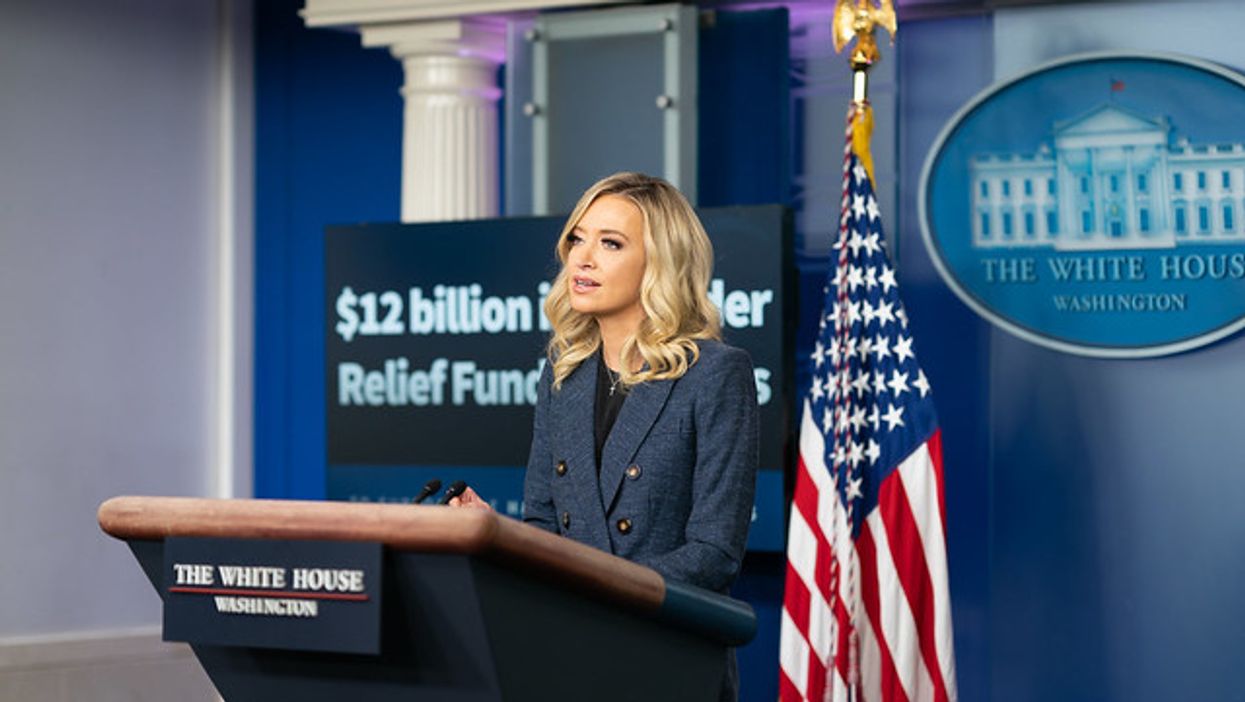McEnany Cites Failed Pandemic Exercise To Prove White House Was Prepared

White House press secretary Kayleigh McEnany
White House press secretary Kayleigh McEnany claimed on Thursday that the Obama administration had left behind an "insufficient" pandemic response plan, and that Donald Trump had replaced it with a superior version that left his team completely prepared to face the current coronavirus crisis.
"The Obama-Biden plan that has been referenced was insufficient," McEnany said during a press gaggle, citing the former administration's pandemic playbook, first reported by Politico back in March.
She then bragged that the Trump administration had instead put together "an entire 2018 pandemic preparedness report," and "did a whole exercise on pandemic preparedness in August of last year and had an entire after-action report put together" on the matter.
The "Obama-Biden paper packet," McEnany claimed, was replaced with a "Trump-style pandemic preparedness response plan."
She then held up the two plans for emphasis, showing that the Trump plan had been collated in a colorful three-ring binder.
It was not immediately clear to what "2018 pandemic preparedness report" McEnany was referring.
As Ronald Klain, former chief of staff for Vice Presidents Joe Biden and Al Gore, noted on Thursday, McEnany may have been citing the administration's 2018 National Biodefense Strategy report, which clocks in at eight pages long and lays out broad-sweeping objectives for "countering biological threats and incidents" through a "layered risk management approach."
McEnany also appeared to be holding up copies of the "Pandemic Crisis Action Plan Ver. 2.0" and a report titled "CONTAGION 2019 FUNCTIONAL EXERCISE," neither of which were published in 2018.
The 2019 pandemic exercise McEnany mentioned was in fact a disaster, according to the New York Times, which reported in March that the simulation had exposed "how underfunded, underprepared and uncoordinated the federal government would be for a life-or-death battle with a virus for which no treatment existed."
In a March 20 interview with NPR, David Sanger, one of the Times reporters who uncovered the 2019 simulation, which actually ran between January and August last year, explained that some of the same issues currently facing the Trump administration — which has been criticized for its slow and chaotic response to the current outbreak — were foreshadowed in that exercise.
He noted that during the exercise there was "a difference of opinion about when to close schools," as well as "an overwhelming number of hospitalizations."
"The simulation suggested that in the environment they imagined, there would be 110 million people roughly who came down with this, 7.7 million of whom would require hospitalization, and 586,000 would die," he said. "So that's a pretty stark number and then leads you to the next questions, are we ready to do 7.7 million hospitalizations?"
He added, "So what does this tell you? Either that it didn't float up to the president — we know the National Security Council was involved in the simulation — or it tells you that it did float up, and it was the basis on which members of the Department of Health and Human Services and others were advising the president about the course that this would take."
During the actual crisis, states were indeed forced to make their own varied decisions about when and how to close schools, and many hospitals were overwhelmed, especially in places like New York City.
The Times report also indicated that states and hospitals were confused about what equipment was stockpiled during the exercise, an issue that the Trump administration struggled with during the early days of the pandemic.
The Trump administration has been widely panned for failing to utilize its own "69-page National Security Council playbook on fighting pandemics," Politico reported in March.
The administration was reportedly "briefed on the playbook's existence in 2017," according to former officials. However, they noted that the findings "never went through a full, National Security Council-led interagency process to be approved as Trump administration strategy."
The Department of Health and Human Services told Politico at the time that its COVID-19 response was instead "informed by more recent plans such as the foundation of the National Biodefense Strategy (2018), Biological Incident Annex (2017),and panCAP (2018) among other key plans provided by the CDC, White House Task Force, FEMA, and other key federal departments and agencies."
The Trump administration's overall approach to the pandemic has been lackluster at best.
A lack of testing capabilities, especially in the early weeks of the crisis, meant that health experts were unable to know the extent of the spread of the virus. And when test kits were finally rolled out, they were determined to be faulty, further delaying the country's ability to respond to the growing threat.
Trump, meanwhile, has refused to maintain a coherent message throughout the crisis, often dismissing the severity of the coronavirus and recommending unproven cures — such as suggesting doctors inject disinfectants into patients' bodies or pushing untested drugs used to treat other diseases — not supported by medical experts.
As of Thursday afternoon, more than 1.4 million people had tested positive for the new coronavirus, and at least 84,938 people had died.
Published with permission of The American Independent Foundation.
- White House Press Secretary Delivers Canned Response To ... ›
- Trump's Press Secretary Claims 'Not A Single American Died” Due ... ›
- New Press Secretary Got Virus Prediction Dead Wrong - National ... ›
- McEnany Won’t Say Trump Will Accept Election Result - National Memo ›
- In Convention Speech, McEnany Claims Trump Protected 'Pre-Existing Conditions' Coverage - National Memo ›
- ‘It’s On Tape’: McEnany Lies In Face Of Woodward Recordings (VIDEO) ›








